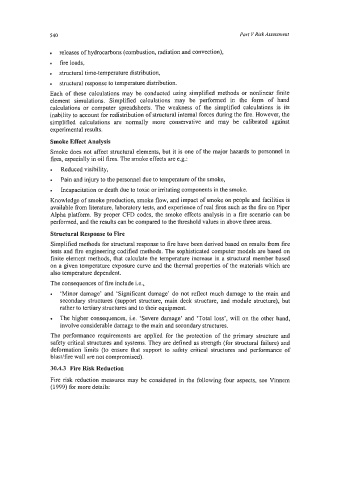Page 564 - Marine Structural Design
P. 564
540 Pari V Risk Assessment
releases of hydrocarbons (combustion, radiation and convection),
fireloads,
structural time-temperature distribution,
structural response to temperature distribution.
Each of these calculations may be conducted using simplified methods or nonlinear finite
element simulations. Simplified calculations may be performed in the form of hand
calculations or computer spreadsheets. The weakness of the simplified calculations is its
inability to account for redistribution of structural internal forces during the fire. However, the
simplified calculations are normally more conservative and may be calibrated against
experimental results.
Smoke Effect Analysis
Smoke does not affect structural elements, but it is one of the major hazards to personnel in
fires, especially in oil fires. The smoke effects are e.g.:
Reduced visibility,
Pain and injury to the personnel due to temperature of the smoke,
Incapacitation or death due to toxic or irritating components in the smoke.
Knowledge of smoke production, smoke flow, and impact of smoke on people and facilities is
available from literature, laboratory tests, and experience of real fires such as the fire on Piper
Alpha platform. By proper CFD codes, the smoke effects analysis in a fire scenario can be
performed, and the results can be compared to the threshold values in above three areas.
Structural Response to Fire
Simplified methods for structural response to fire have been derived based on results fiom fire
tests and fire engineering codified methods. The sophisticated computer models are based on
finite element methods, that calculate the temperature increase in a structural member based
on a given temperature exposure curve and the thermal properties of the materials which are
also temperature dependent.
The consequences of fire include i.e.,
‘Minor damage’ and ‘Significant damage’ do not reflect much damage to the main and
secondary structures (support structure, main deck structure, and module structure), but
rather to tertiary structures and to their equipment.
The higher consequences, Le. ‘Severe damage’ and ‘Total loss’, will on the other hand,
involve considerable damage to the main and secondary structures.
The performance requirements are applied for the protection of the primary structure and
safety critical structures and systems. They are defined as strength (for structural failure) and
deformation limits (to ensure that support to safety critical structures and performance of
blasvfire wall are not compromised).
30.4.3 Fire Risk Reduction
Fire risk reduction measures may be considered in the following four aspects, see Vinnem
(1 999) for more details:

